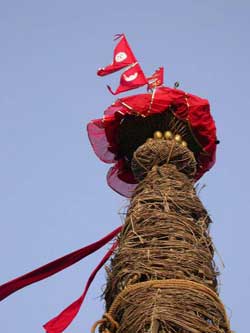Bungamati had the Machendranath Rath up and ready for the once-in-twelve-years haul to Patan on 2 May. The road that links this town to Patan was graded and rolled over to take on the rath. The chariot itself had spanking new wooden wheels and a new chassis of wood from a massive tree bought for Rs 100 thousand and lugged over from Trisuli.
Unfortunately, the citizens of Bungamati had not managed to clean up their town for this great opportunity. Although there is an 'industrial fair' on, and the town clearly hopes to take advantage of the tourism and publicity from this year's jatra, the town looked decrepit and dirty. The rath itself was parked at the back of the town amidst a perfunctorily cleaned up garbage dump. While the sikhara-style temple of Bungadya is tackily painted, the rest of the town remains in dejected old-world squalor reminiscent of a Patan of half a century ago.
Bungadya itself is the 'local' name of the god, who is also Avalokitswar and Machendranath. The long sojourn to Patan of the historically unstable and top-heavy rath is an event in itself. The route ran along the ridgetop that runs north along the Nakkhu River. This was the first time in the rath's historical travel that Bungadya will see so much urbanisation en-route to Patan. A dozen years ago, Bhaisepati was still the rural kaanth of the Valley towns. The next time Bungadya makes the trip, it will be a city all the way to
Patan. Still, all you had to do was turn your eyes across the Nakkhu River to the rice paddies on the other side to see how it must have looked in the past.




